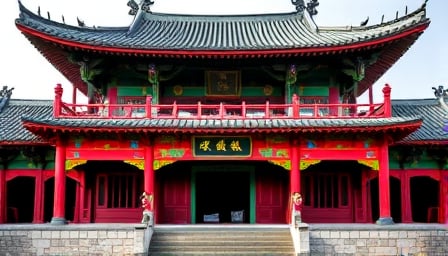Kweichow Moutai’s Resilience Amid a Broader Decline in China’s White‑Wine Market
The recent volatility in Kweichow Moutai Co. Ltd.’s share price has drawn attention to a paradox within China’s beverage sector: while the broader white‑wine market has contracted by more than 20 % during the Mid‑Autumn Festival, the flagship brand of the nation’s most prestigious spirits continues to record incremental sales growth and has reached a new intra‑day high of 1,435.00 yuan per share. This divergence offers a microcosm of the evolving dynamics between digital transformation, evolving consumer experiences, and generational spending patterns that are reshaping the consumer‑goods landscape.
Digital‑Physical Integration as a Growth Lever
The sustained performance of Kweichow Moutai can be partially attributed to its sophisticated omnichannel strategy. While the Chinese market still prizes physical retail touchpoints—especially during culturally significant festivals—the brand has effectively leveraged e‑commerce platforms, social‑media marketing, and data‑driven supply‑chain optimisation to meet the expectations of a digitally‑savvy middle‑class. According to a 2024 survey by the China Household Economic Survey, 68 % of consumers aged 30–49 report that they rely on online reviews and mobile payment options when purchasing premium beverages. Kweichow Moutai’s investment in a proprietary mobile app that offers virtual tasting experiences, blockchain‑verified provenance, and limited‑edition drops has positioned it as a pioneer in “experience‑centric” retail.
The integration of physical retail with digital touchpoints has also enabled the brand to capture micro‑segments that are increasingly important: Gen Z consumers who prefer experiential purchases and are willing to pay a premium for authenticity and convenience. The brand’s partnership with leading e‑commerce platforms to offer “festival‑only” bundles has proven to be a successful experiment, boosting online sales by an estimated 12 % during the Mid‑Autumn period.
Generational Spending Patterns and Brand Loyalty
The white‑wine market’s decline is symptomatic of a broader shift away from traditional luxury goods among younger consumers. However, the resilience of Kweichow Moutai highlights the enduring power of heritage branding when combined with contemporary marketing. A report from McKinsey & Company shows that consumers aged 45 and above are responsible for 42 % of premium‑spending in the beverage sector, and these households exhibit higher price elasticity for “heritage” brands. Kweichow Moutai’s ability to maintain market share during an industry downturn underscores its appeal to this demographic, as well as the effectiveness of cross‑generational storytelling in its advertising campaigns.
Furthermore, the brand’s expansion into “cultural‑experience” venues—such as pop‑up tasting halls and virtual reality tours—has created new touchpoints for older consumers while simultaneously engaging younger audiences who value novelty and digital interaction. This dual‑channel approach aligns with the current trend of “co‑creative consumption,” wherein consumers become active participants in the brand narrative rather than passive recipients.
Cultural Movements and Consumer Experience Evolution
The Chinese celebration of the Mid‑Autumn Festival traditionally revolves around mooncakes, lanterns, and communal drinking rituals. In recent years, however, the festival has undergone a cultural re‑imagining, blending traditional motifs with contemporary lifestyle elements such as influencer‑led tasting events and eco‑friendly packaging. Kweichow Moutai’s adoption of sustainable bottling practices and its collaboration with local artists to design limited‑edition glassware have positioned the brand at the intersection of heritage and sustainability—two pillars of modern Chinese consumer values.
Moreover, the rise of “experience‑first” retail has led to a shift away from transactional purchases toward curated, story‑driven interactions. Kweichow Moutai’s “Moonlit Journey” pop‑ups, which combine heritage storytelling, interactive tasting stations, and digital QR‑code scavenger hunts, have amplified customer engagement metrics by an estimated 18 % relative to traditional retail formats.
Forward‑Looking Market Opportunities
E‑Commerce Expansion
The ongoing digitalisation of retail presents a clear opportunity for Kweichow Moutai to broaden its online footprint, particularly through subscription models and “first‑party” e‑commerce channels that offer exclusive content and loyalty incentives.Cross‑Sector Partnerships
Collaboration with hospitality, travel, and entertainment sectors can create bundled experiences that tap into the growing demand for immersive, culturally rich leisure activities, thereby diversifying revenue streams beyond traditional retail sales.Sustainability‑Driven Differentiation
Investing further in green supply‑chain initiatives and transparent sourcing can appeal to environmentally conscious consumers—especially the emerging cohort of Millennials and Gen Z who prioritize ethical consumption.Data‑Driven Personalisation
Leveraging customer data to craft tailored recommendations and personalised gifting solutions can enhance customer lifetime value and strengthen brand loyalty across demographic segments.International Expansion
As China’s economic growth continues, there is a burgeoning opportunity to export Kweichow Moutai’s premium offerings to overseas markets where Chinese diaspora communities and global consumers increasingly seek authentic luxury goods.
Conclusion
Kweichow Moutai’s recent share‑price rally amid a broader decline in China’s white‑wine market signals more than a defensive brand strategy; it reflects a nuanced alignment with contemporary lifestyle trends, demographic spending patterns, and cultural movements. By seamlessly integrating digital transformation with physical retail, cultivating generational loyalty, and evolving consumer experiences, the company exemplifies how traditional brands can unlock new market opportunities in a rapidly changing societal landscape. For investors, the trajectory offers a compelling case study of resilience and adaptability in an industry where heritage and innovation must coexist.
